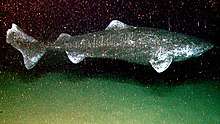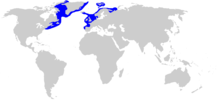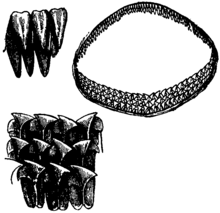Greenland shark
The Greenland shark (Somniosus microcephalus), also known as the gurry shark, grey shark, or by the Kalaallisut name eqalussuaq, is a large shark of the family Somniosidae ("sleeper sharks"), closely related to the Pacific and southern sleeper sharks.[2] The distribution of this species is mostly restricted to the waters of the North Atlantic Ocean and Arctic Ocean.
| Greenland shark | |
|---|---|
 | |
| Scientific classification | |
| Kingdom: | Animalia |
| Phylum: | Chordata |
| Class: | Chondrichthyes |
| Order: | Squaliformes |
| Family: | Somniosidae |
| Genus: | Somniosus |
| Species: | S. microcephalus |
| Binomial name | |
| Somniosus microcephalus (Bloch & J. G. Schneider, 1801) | |
 | |
| Range of the Greenland shark | |
| Synonyms | |
| |
Greenland sharks have the longest known lifespan of all vertebrate species (estimated to be between 300–500 years), and the species is among the largest extant species of shark. As an adaptation to living at depth,[3] it has a high concentration of trimethylamine N-oxide in its tissues, which causes the meat to be toxic.[4] Greenland shark flesh treated to reduce toxin levels is eaten in Iceland as a delicacy known as kæstur hákarl.[5]
Description
The Greenland shark is one of the largest living species of shark. Greenland sharks grow to 6.4 m (21 ft) and 1,000 kg (2,200 lb),[6][7] and possibly up to 7.3 m (24 ft) and more than 1,400 kg (3,100 lb).[8][9] Most Greenland sharks observed have been around 2.44–4.8 m (8.0–15.7 ft) long and weigh up to 400 kg (880 lb).[8][9]
Males are typically smaller than females. It rivals the Pacific sleeper shark (possibly up to 7 m or 23 ft long) as the largest species in the family Somniosidae. The Greenland shark is a thickset species, with a short, rounded snout, small eyes, and very small dorsal and pectoral fins. The gill openings are very small for the species' great size.
Coloration can range from pale creamy-gray to blackish-brown and the body is typically uniform in color, though whitish spots or faint dark streaks are occasionally seen on the back.[8]
Dentition

When feeding on large carcasses, the shark employs a rolling motion of its jaw. The 48-52 teeth of the upper jaw are very thin and pointed, lacking serrations. These upper jaw teeth act as an anchor while the lower jaw proceeds to cut massive chunks out of their prey for a quick and easy meal.
The 48-52 lower teeth are interlocking and are broad and square, containing short, smooth cusps that point outward.[8] Teeth in the two halves of the lower jaw are strongly pitched in opposite directions.[10]
Life history
Diet
The Greenland shark is an apex predator and mostly eats fish. It has never been observed hunting.[11] Recorded fish prey have included smaller sharks, skates, eels, herring, capelin, Arctic char, cod, rosefish, sculpins, lumpfish, wolffish, and flounder.[8]
Greenland sharks have also been found with remains of seals, polar bears, moose,[12] and reindeer (in one case an entire reindeer body) in their stomachs.[8][13] The Greenland shark is known to be a scavenger, and is attracted by the smell of rotting meat in the water. The sharks have frequently been observed gathering around fishing boats.[8] It also scavenges on seals.[11]
Although such a large shark could easily consume a human swimmer, the frigid waters it typically inhabits make the likelihood of attacks on humans very low, and no cases of predation on people have been verified.[8]
Other behavior
As an ectotherm living in a just-above-freezing environment, the Greenland shark has the lowest swim speed and tail-beat frequency for its size across all fish species, which most likely correlates with its very slow metabolism and extreme longevity. It swims at 1.22 km/h (0.76 mph), with its fastest cruising speed only reaching 2.6 km/h (1.6 mph).[14] Because this top speed is only half that of a typical seal in their diet, biologists are uncertain how the sharks are able to prey on the faster seals. It is hypothesized that they may ambush them while they sleep.[15]
Greenland sharks migrate annually based on depth and temperature rather than distance, although some do travel. During the winter, the sharks congregate in the shallows (up to 80° north) for warmth but migrate separately in summer to the deeps or even farther south. The species has been observed at a depth of 2,200 metres (7,200 ft) by a submersible investigating the wreck of the SS Central America that lies about 160 miles (260 km) east of Cape Hatteras, North Carolina.[16] Daily vertical migration between shallower and deeper waters has also been recorded.[17]
In August 2013, researchers from Florida State University caught the first documented Greenland shark in the Gulf of Mexico at a depth of 1,749 m (5,738 ft), where the water temperature was 4.1 °C (39.4 °F).[18] A more typical depth range is 0–1,500 m (0–4,900 ft), with the species often occurring in relatively shallow waters in the far north and deeper in the southern part of its distribution.[19][20]
The shark is often colonized by the copepod Ommatokoita elongata, which attaches itself to the shark's eyes.[21] It was speculated that the copepod may display bioluminescence and thus attract prey for the shark in a mutualistic relationship, but this hypothesis has not been verified.[22] The shark occupies what tends to be a very deep environment seeking its preferable cold water (−0.6 to 12 °C or 30.9 to 53.6 °F) habitat.[1]
When hoisted upon deck, it beats so violently with its tail, that it is dangerous to be near it, and the seamen generally dispatch it, without much loss of time. The pieces that are cut off exhibit a contraction of their muscular fibres for some time after life is extinct. It is, therefore, extremely difficult to kill, and unsafe to trust the hand within its mouth, even when the head is cut off. And, if we are to believe Crantz, this motion is to be observed three days after, if the part is trod on or struck.
— Henry William Dewhurst, The Natural History of the Order Cetacea (1834)[23]
Longevity
The Greenland shark has the longest known lifespan of all vertebrate species.[24] One Greenland shark was tagged off the coast of Greenland in 1936 and recaptured in 1952. Its measurements suggest that Greenland sharks grow at a rate of 0.5–1 cm (0.2–0.4 in) per year.[25] In 2016, a study based on 28 specimens that ranged from 81 to 502 cm (2.7–16.5 ft) in length determined by radiocarbon dating of crystals within the lens of their eyes, that the oldest of the animals that they sampled, which also was the largest, had lived for 392 ± 120 years and was consequently born between 1504 and 1744.n1 The authors further concluded that the species reaches sexual maturity at about 150 years of age.[24][26][27]
Reproduction
As recently as 1957, females were found not to deposit eggs in the bottom mud, but retain the developing embryos within their bodies so they are born alive after an undetermined gestation period (a process known as ovoviviparity). About ten pups per litter is normal, each initially measuring some 38–42 cm (15–17 in) in length.[26][28]
Physiological adaptations

Like other elasmobranchii, Greenland sharks have high concentrations of the nitrogenous waste products urea and trimethylamine N-oxide (TMAO) in their tissues, which increases their buoyancy[29] and function as osmoprotectants. TMAO also counteracts the protein-destabilizing tendencies of urea[30][31] and of deep-water pressure.[3][31] Its presence in the tissues of both elasmobranch and teleost fish has been found to increase with depth.[3][32]
The blood of Greenland sharks contains three major types of hemoglobin, made up of two copies of α globin combined with two copies of three very similar β subunits. These three types show very similar oxygenation and carbonylation properties, which are unaffected by urea, an important compound in marine elasmobranch physiology. They display identical electronic absorption and resonance Raman spectra, indicating that their heme-pocket structures are identical or highly similar. The hemoglobins also have a lower affinity for O2 compared to temperate sharks. These characteristics are interpreted as adaptations to living at great water depths.[33]
As food
The flesh of the Greenland shark is toxic because of the presence of high concentrations of trimethylamine oxide (TMAO). If the meat is eaten without pretreatment, the ingested TMAO is metabolized into trimethylamine, which can produce effects similar to extreme drunkenness. Occasionally, sled dogs that eat the flesh are unable to stand up because of this effect. Similar toxic effects occur with the related Pacific sleeper shark, but not in most other shark species.[34][35]
The meat can be treated for safe consumption by boiling in several changes of water, drying, or fermenting for several months to produce kæstur hákarl. Traditionally, this is done by burying the meat in boreal ground for 6–8 weeks, which presses the TMAO out of the meat and also results in partial fermentation. The meat is then dug up and hung up in strips to dry for several more months.[36] It is considered a delicacy in Iceland.[37][38]
Inuit legends
The Greenland shark's poisonous flesh has a high urea content, which gave rise to the Inuit legend of Skalugsuak, the first Greenland shark.[39] The legend says that an old woman washed her hair in urine and dried it with a cloth. The cloth blew into the ocean to become Skalugsuak.[40] Another legend tells of a girl whose father cut off her fingers while drowning her, with each finger turning into a sea creature, including Skalugsuak.[41]
The Greenland shark plays a role in cosmologies of the Inuit from the Canadian Eastern Arctic and Greenland. Igloolik Inuit believe that the shark lives within the urine pot of Sedna, goddess of the sea, and consequently its flesh has a urine-like smell, and acts as a helping spirit to shamans.[42]
See also
- List of sharks
References
- Kyne, P.M.; Sherrill-Mix, S.A. & Burgess, G.H. (2006). "Somniosus microcephalus". IUCN Red List of Threatened Species. 2006: e.T60213A12321694. doi:10.2305/IUCN.UK.2006.RLTS.T60213A12321694.en.
- Yano, Kazunari; Stevens, John D.; Compagno, Leonard J. V. (2004). "A review of the systematics of the sleeper shark genus Somniosus with redescriptions of Somniosus (Somniosus) antarcticus and Somniosus (Rhinoscymnus) longus (Squaliformes: Somniosidae)". Ichthyological Research. 51 (4): 360–73. doi:10.1007/s10228-004-0244-4.
- Yancey, Paul H.; Gerringer, Mackenzie E.; Drazen, Jeffrey C.; Rowden, Ashley A.; Jamieson, Alan (2014). "Marine fish may be biochemically constrained from inhabiting the deepest ocean depths". Proceedings of the National Academy of Sciences of the United States of America. 111 (12): 4461–5. Bibcode:2014PNAS..111.4461Y. doi:10.1073/pnas.1322003111. PMC 3970477. PMID 24591588.
- Anthoni, Uffe; Christophersen, Carsten; Gram, Lone; Nielsen, Niels H.; Nielsen, Per (1991). "Poisonings from flesh of the Greenland shark Somniosus microcephalus may be due to trimethylamine". Toxicon. 29 (10): 1205–12. doi:10.1016/0041-0101(91)90193-U. PMID 1801314.
- Durst, Sidra (2012). "Hákarl". In Deutsch, Jonathan; Murakhver, Natalya (eds.). They Eat That? A Cultural Encyclopedia of Weird and Exotic Food from around the World. pp. 91–2. ISBN 978-0-313-38059-4.
- Mills, Patrick (2006). Dewey, Tanya (ed.). "Somniosus microcephalus". Animal Diversity Web. University of Michigan.
- McClain, Craig R.; Balk, Meghan A.; Benfield, Mark C.; Branch, Trevor A.; Chen, Catherine; Cosgrove, James; Dove, Alistair D.M.; Gaskins, Lindsay C.; Helm, Rebecca R. (13 January 2015). "Sizing ocean giants: patterns of intraspecific size variation in marine megafauna". PeerJ. 3: e715. doi:10.7717/peerj.715. ISSN 2167-8359. PMC 4304853. PMID 25649000.
- Eagle, Dane. "Greenland shark". Florida Museum of Natural History. Retrieved 26 June 2012.
- Wood, Gerald (1983). The Guinness Book of Animal Facts and Feats. ISBN 978-0-85112-235-9.
- "Greenland Shark". Marinebiodiversity.ca. Centre for Marine Biodiversity. Archived from the original on 3 April 2014. Retrieved 23 May 2011.
- Yong, Ed (11 August 2016). "The Sharks That Live to 400". The Atlantic. Retrieved 15 August 2016.
- "Moose-eating shark rescued in Newfoundland harbour". CBC News. 21 November 2013. Retrieved 21 November 2013.
- Howden, Daniel (12 August 2008). "Clash of the fiercest predators as shark eats polar bear". The Independent. Retrieved 26 June 2012.
- Watanabe, Yuuki Y.; Lydersen, Christian; Fisk, Aaron T.; Kovacs, Kit M. (2012). "The slowest fish: Swim speed and tail-beat frequency of Greenland sharks". Journal of Experimental Marine Biology and Ecology. 426–427: 5–11. doi:10.1016/j.jembe.2012.04.021.
- Scales, Helen (June 2012). "Slow Sharks Sneak Up on Sleeping Seals (and Eat Them)?". National Geographic News. Retrieved 28 December 2012.
- "AMERICA'S LOST TREASURE". www.sscentralamerica.com. Archived from the original on 24 November 2016. Retrieved 14 February 2017.
- Owen, D. (2009). Shark: In peril in the sea. Allen & Unwin.
- Grubs, Dean (15 August 2013). "Deep-C Scientists Capture First Greenland Shark in the Gulf of Mexico". deep-c.org
- Yano, K.; Stevens, J.D.; Compagno, L.J.V. (2007). "Distribution, reproduction and feeding of the Greenland shark Somniosus (Somniosus) microcephalus, with notes on two other sleeper sharks, Somniosus (Somniosus) pacificus and Somniosus (Somniosus) antarcticus". Journal of Fish Biology. 70 (2): 374–390. doi:10.1111/j.1095-8649.2007.01308.x.
- Møller, P.R.; Nielsen, J.; Knudsen, S.W.; Poulsen, J.Y.; Sünksen, K.; Jørgensen, O.A. (2010). "A checklist of the fish fauna of Greenland waters". Zootaxa. 2378 (1): 1–84.
- Borucinska, J. D.; Benz, G. W.; Whiteley, H. E. (1998). "Ocular lesions associated with attachment of the parasitic copepod Ommatokoita elongata (Grant) to corneas of Greenland sharks, Somniosus microcephalus (Bloch & Schneider)". Journal of Fish Diseases. 21 (6): 415–22. doi:10.1046/j.1365-2761.1998.00122.x.
- Berland, Bjørn (1961). "Copepod Ommatokoita elongata (Grant) in the Eyes of the Greenland Shark—a Possible Cause of Mutual Dependence". Nature. 191 (4790): 829–30. Bibcode:1961Natur.191..829B. doi:10.1038/191829a0.
- Henry W. Dewhurst (1834). The Natural History of the order Cetacea and the oceanic inhabitants of the arctic regions: Illustrated with numerous lithographic and wood engravings. Verf.
- Nielsen, Julius; Hedeholm, Rasmus B.; Heinemeier, Jan; Bushnell, Peter G.; Christiansen, Jørgen S.; Olsen, Jesper; Ramsey, Christopher Bronk; Brill, Richard W.; Simon, Malene; Steffensen, Kirstine F.; Steffensen, John F. (2016). "Eye lens radiocarbon reveals centuries of longevity in the Greenland shark (Somniosus microcephalus)". Science. 353 (6300): 702–4. Bibcode:2016Sci...353..702N. doi:10.1126/science.aaf1703. PMID 27516602. Lay summary – Sci News (12 August 2016).
- Caloyianis, Nick (September 1998). "Greenland Sharks". National Geographic. 194 (3): 60–71.
- Pennisi, Elizabeth (11 August 2016). "Greenland Shark May Live 400 Years, Smashing Longevity Record". Science Magazine.
- The Strange and Gruesome Story of the Greenland Shark, the Longest-Living Vertebrate on Earth, The New Yorker, M. R. O’Connor, November 25, 2017. Retrieved November 27, 2017.
- Martin, R. Aidan. "Greenland Shark". Retrieved 23 May 2011.
- Withers, Philip C.; Morrison, Garrick; Guppy, Michael (1994). "Buoyancy Role of Urea and TMAO in an Elasmobranch Fish, the Port Jackson Shark, Heterodontus portusjacksoni". Physiological Zoology. 67 (3): 693–705. doi:10.1086/physzool.67.3.30163765. JSTOR 30163765.
- Bennion, Brian J.; Daggett, Valerie (2004). "Counteraction of urea-induced protein denaturation by trimethylamine N-oxide: a chemical chaperone at atomic resolution". Proceedings of the National Academy of Sciences of the United States of America. 101 (17): 6433–8. Bibcode:2004PNAS..101.6433B. doi:10.1073/pnas.0308633101. PMC 404062. PMID 15096583.
- Yancey, Paul H. (2005). "Organic osmolytes as compatible, metabolic and counteracting cytoprotectants in high osmolarity and other stresses". The Journal of Experimental Biology. 208 (Pt 15): 2819–30. doi:10.1242/jeb.01730. PMID 16043587.
- Treberg, Jason R.; Driedzic, William R. (2002). "Elevated levels of trimethylamine oxide in deep-sea fish: evidence for synthesis and intertissue physiological importance". Journal of Experimental Zoology. 293 (1): 39–45. doi:10.1002/jez.10109. PMID 12115917.
- Russo, Roberta; et al. (12 October 2017). "The Greenland Shark Somniosus Microcephalus—Hemoglobins and Ligand-Binding Properties". PLOS ONE. 12 (10): e0186181. Bibcode:2017PLoSO..1286181R. doi:10.1371/journal.pone.0186181. PMC 5638460. PMID 29023598.
- "The Greenland Shark Is A Very Odd Species Of Shark – Shark Sider". Retrieved 17 August 2016.
- "The Greenland Shark: An Icy Mystery". Greenland Shark | Sharkopedia Sharkopedia. Archived from the original on 7 January 2018. Retrieved 17 August 2016.
- Wheatley, Gale (20 September 2010). "Iceland's Wild Culinary Traditions: Hákarl and Brennivín".
- Blumenfeld, Jenna (16 June 2011). "My Encounter With Hákarl, The Worst Tasting Food On Earth".
- "Hákarl – Icelandic Fermented Shark". Islands. Retrieved 13 August 2016.
- O'Reilly, Lindsay (2004). "Skalugsuak's origins". Canadian Geographic. Archived from the original on 21 March 2016. Retrieved 13 August 2016.
- "Greenland Shark and Elasmobranch Education and Research Group". Greenland Shark and Elasmobranch Education and Research Group. Archived from the original on 14 October 2013. Retrieved 13 August 2016.
- Helfman, Gene; Burgess, George H. (2014). Sharks: The Animal Answer Guide. Johns Hopkins University Press.
- Idrobo, Carlos Julián (2009). The Pangnirtung Inuit and the Greenland Shark (PDF) (MSc Thesis). University of Manitoba. p. 66. OCLC 855389661.
Notes
- 1.^n1 2016-272=1744, 2016-512=1504.
Further reading
- MacNeil, M. A.; McMeans, B. C.; Hussey, N. E.; Vecsei, P.; Svavarsson, J.; Kovacs, K. M.; Lydersen, C.; Treble, M. A.; et al. (2012). "Biology of the Greenland shark Somniosus microcephalus". Journal of Fish Biology. 80 (5): 991–1018. doi:10.1111/j.1095-8649.2012.03257.x. PMID 22497371.
- Watanabe, Yuuki Y.; Lydersen, Christian; Fisk, Aaron T.; Kovacs, Kit M. (2012). "The slowest fish: Swim speed and tail-beat frequency of Greenland sharks". Journal of Experimental Marine Biology and Ecology. 426–427: 5–11. doi:10.1016/j.jembe.2012.04.021. Lay summary – LiveScience (25 June 2012).
External links
| Wikimedia Commons has media related to Somniosus microcephalus. |
| Wikispecies has information related to Somniosus microcephalus |
- Greenland Shark and Elasmobranch Education and Research Group
- Canadian Museum of Nature SV Greenland Shark
- "Somniosus microcephalus". Integrated Taxonomic Information System. Retrieved 23 January 2006.
- Froese, Rainer and Pauly, Daniel, eds. (2006). "Somniosus microcephalus" in FishBase. May 2006 version.
- "Greenland Shark" on As It Happens May 6, 2008; CBC Radio 1(WMV file)
